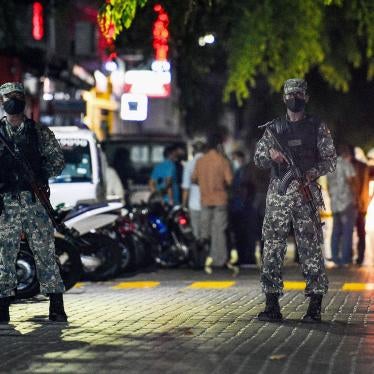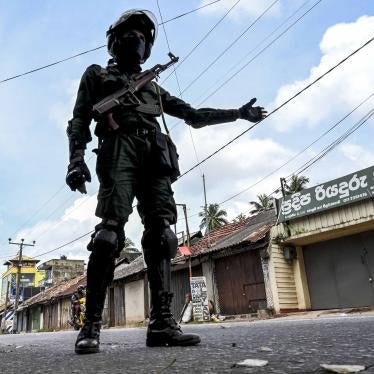(New York) – Civilian deaths in Afghanistan from US and NATO airstrikes nearly tripled from 2006 to 2007, with recent deadly airstrikes exacerbating the problem and fuelling a public backlash, Human Rights Watch said in a new report released today. The report also condemns the Taliban’s use of “human shields” in violation of the laws of war.
Though operational changes advocated by Human Rights Watch have reduced the rate of civilian casualties since they spiked in July 2007, continuing tragedies, such as the July 6, 2008 strike on a wedding party and the August 22, 2008 bombing in Azizabad, have greatly undermined local support for the efforts of international forces providing security in Afghanistan.
The 43-page report, “‘Troops in Contact’: Airstrikes and Civilian Deaths in Afghanistan,” analyzes the use of airstrikes by US and NATO forces and resulting civilian casualties, particularly when used to make up for the lack of ground troops and during emergency situations. Human Rights Watch found few civilian deaths resulted from planned airstrikes, while almost all deaths occurred in unplanned airstrikes.
“Rapid response airstrikes have meant higher civilian casualties, while every bomb dropped in populated areas amplifies the chance of a mistake,” said Brad Adams, Asia director at Human Rights Watch. “Mistakes by the US and NATO have dramatically decreased public support for the Afghan government and the presence of international forces providing security to Afghans.”
The report documents how insurgent forces have contributed to the civilian toll from airstrikes by deploying their forces in populated villages, at times with the specific intent to shield their forces from counterattack, a serious violation of the laws of war. Human Rights Watch found several instances where Taliban forces purposefully used civilians as shields to deter US and NATO attacks.
In 2006, at least 929 Afghan civilians were killed in fighting related to the armed conflict. Of those, at least 699 died during Taliban attacks (including suicide bombings and other bombings unlawfully targeting civilians) and at least 230 died during US or NATO attacks. Of the latter, 116 were killed by US or NATO airstrikes. In 2007, at least 1,633 Afghan civilians were killed in fighting related to the armed conflict. Of those, some 950 died during attacks by the various insurgent forces, including the Taliban and al-Qaeda. At least 321 were killed by US or NATO airstrikes. Thus, civilian deaths from US and NATO airstrikes nearly tripled from 2006 to 2007.
In the first seven months of 2008, at least 540 Afghan civilians were killed in fighting related to the armed conflict. Of those, at least 367 died during attacks by the various insurgent forces and 173 died during US or NATO attacks. At least 119 were killed by US or NATO airstrikes. For all periods cited, Human Rights Watch uses the most conservative figures available.
Human Rights Watch criticized the poor response by US officials when civilian deaths occur. Prior to conducting investigations into airstrikes causing civilian loss, US officials often immediately deny responsibility for civilian deaths or place all blame on the Taliban. US investigations conducted have been unilateral, ponderous, and lacking in transparency, undercutting rather than improving relations with local populations and the Afghan government. A faulty condolence payment system has not provided timely and adequate compensation to assist civilians harmed by US actions.
“The US needs to end the mistakes that are killing so many civilians,” said Adams. “The US must also take responsibility, including by providing timely compensation, when its airstrikes kill Afghan civilians. While Taliban shielding is a factor in some civilian deaths, the US shouldn’t use this as an excuse when it could have taken better precautions. It is, after all, its bombs that are doing the killing.”
Human Rights Watch found that few civilians casualties occurred as the result of planned airstrikes on suspected Taliban targets. Instead, most cases of civilian deaths from airstrikes occurred during the fluid, rapid-response strikes mostly carried out in support of “troops in contact” – ground troops who are under insurgent attack. Such unplanned strikes included situations where US special forces units – normally small in number and lightly armed – came under insurgent attack; in US/NATO attacks in pursuit of insurgent forces who had retreated to populated villages; and in air attacks where US “anticipatory self-defense” rules of engagement applied.
The effects of airstrikes go beyond civilian deaths. For example, an investigation by the Afghan government found that two battles over a three-day period starting April 30, 2007 in Shindand district resulted in the destruction of numerous homes. In every case investigated by Human Rights Watch where airstrikes hit villages, many civilians had to leave the village because of damage to their homes and fear of further strikes. People from neighboring villages also sometimes fled in fear of future strikes on their villages. This has led to large numbers of internally displaced persons.
To respond to public concern and complaints from President Hamid Karzai, in July 2007 the NATO-led International Security Assistance Force (ISAF) announced several changes in targeting tactics. These changes include employing smaller munitions, delaying attacks where civilians might be harmed, and turning over house-to-house searches to the Afghan National Army. A review of available evidence suggests that the changes had some impact, as there was a significant drop in civilian casualties due to airstrikes in the last half of 2007, even as the overall tonnage of bombs dropped increased.
Human Rights Watch welcomed these changes in targeting, but remained concerned by continuing civilian casualties from airstrikes, particularly as the number of airstrikes has increased dramatically and the number of deaths and injuries has spiked this summer.
Human Rights Watch called for the US and NATO to address the rising civilian death toll from unplanned airstrikes, and to fix continuing problems with field collateral damage estimation and the inconsistent application of their Rules of Engagement.
“The recent airstrikes killing dozens of Afghans make clear that the system is still broken and that civilians continue to pay the ultimate price,” said Adams. “Civilian deaths from airstrikes act as a recruiting tool for the Taliban and risk fatally undermining the international effort to provide basic security to the people of Afghanistan.”







